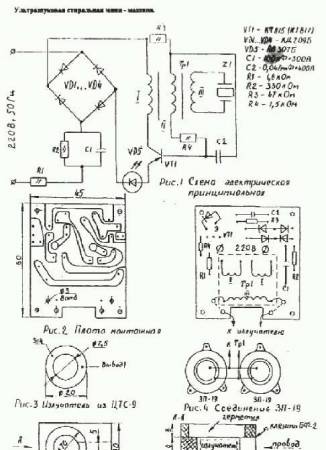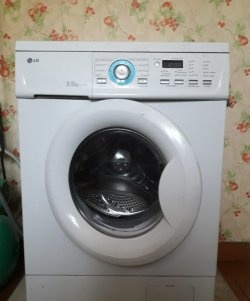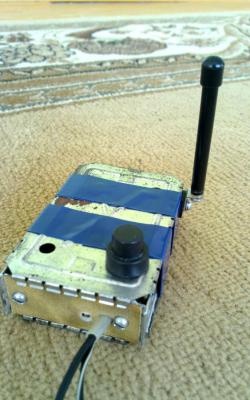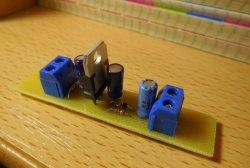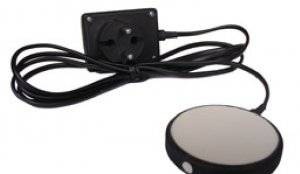
An ultrasonic washing machine is designed for washing clothes using sound vibrations created in the detergent solution, the frequency of which is close to ultrasonic. The features of the USM are that when washing there is no mechanical friction of the laundry, the laundry is completely disinfected after washing by the USM, and the device's power consumption is no more than 15 W.
The device of an ultrasonic washing machine consists of a power supply made according to a transformerless circuit, a pulse generator on a VT1 transistor, a piezoceramic emitter in a sealed waterproof housing. The pulse voltage from the generator is increased to 50 - 55 V using a Tpl transformer. Pulse repetition frequency is within 18-30 kHz. Light-emitting diode VD5 is designed to indicate generator operation.
The device of an ultrasonic washing machine consists of a power supply made according to a transformerless circuit, a pulse generator on a VT1 transistor, a piezoceramic emitter in a sealed waterproof housing. The pulse voltage from the generator is increased to 50 - 55 V using a Tpl transformer. Pulse repetition frequency is within 18-30 kHz. Light-emitting diode VD5 is designed to indicate generator operation.
Manufacturing
The electrical circuit diagram of the device is shown in Fig. 1, drawing of a printed circuit board with the arrangement of elements - in Fig. 2. The pulse transformer is wound on a closed W-shaped core made of soft magnetic ferrite type 600 PV, which is glued from two W-shaped cores W bkhb.Winding I contains 70 turns of PEV-0.3 wire, winding II contains 10 turns of PEV-0.3 wire. winding Ш - 450 turns of the same wire.
Winding is carried out on a two-section frame made of electrical cardboard turn to turn: winding III is located in one section; I and P - in another, and winding II is wound on top of winding I. After winding, the frame is placed on the middle rod of the core Sh bkhb, and the second core Sh bkhb is glued on top with BF-2 glue, forming a closed magnetic circuit. The printed circuit board is made of foil-coated single-sided fiberglass SF with a thickness of 1.5...2 mm.
After assembling and setting up the Tpl trigger, it is advisable to fill it with epoxy resin or sealant. When using serviceable parts and correct assembly, the circuit begins to work immediately. If there is no generation (by ear), you need to swap the ends of winding I. Piezoceramic emitter Z1 in the author's design uses an industrial disk-shaped one (Fig. 3) made of TsTS-9 type ceramics. As a replacement, we can recommend piezo emitters like ZI-19 and the like, connected as shown in Fig. 4.
The hole in the plastic casing of the emitter is carefully expanded to a diameter of 20 mm. The piezo emitter (Fig. 3) is placed in a housing (Fig. 5), glued together from three sheets of plexiglass, fixed in the middle sheet with glue: after sewing with wire, it is filled with sealant to seal the joints. Filling should be done flush with the surfaces of the outer sheets. The channel for passing the wire in the housing is also filled with sealant. The device circuit is placed in a housing from an old power supply (for example, from a microcalculator) and is connected to the emitter with a 2500 mm long vinyl-clad wire.The use of dynamic 4GDV type high-frequency heads as emitters in the design is acceptable, but their service life is short.
When installing the head into a housing similar to that shown in Fig. 5, it must be insulated (wrapped) with thin rubber with tension (especially over the head horn), then filled with sealant.
Operating the device
Soak heavily soiled laundry 2-3 hours before washing. Do the washing in a container with a volume of no more than 15-20 liters in the following sequence:
1. Prepare a container for washing with a ratio of bottom width to height of at least 1:1.5 (bucket, deep basin, etc.)
2. Fill the container with water at a temperature of 40-50° C for synthetics or 60-65° C for cotton and linen. Check the temperature on the label of the fabric being washed.
3. Pour washing powder into the water.
4. Lower the emitter into the middle of the container.
5. Load laundry (no more than 1.5 kg dry weight). Make sure that the laundry floats freely in the washing solution. Wash heavily soiled areas with soap.
6. Connect the device to the network.
7 Washing time is 30-90 minutes; during washing, turn the laundry approximately once every 10-15 minutes. The washing process is invisible. USM is also effective when soaking laundry before washing in a regular machine, while the disinfection effect is also preserved.
8. After finishing washing, disconnect the trigger from the mains, rinse and dry the emitter.
9. Rinse the laundry.
The use of USM is especially effective when washing thin woolen items, delicate linen, etc. In this case, things do not twist, stretch, or lose their shape.
The electrical circuit diagram of the device is shown in Fig. 1, drawing of a printed circuit board with the arrangement of elements - in Fig. 2. The pulse transformer is wound on a closed W-shaped core made of soft magnetic ferrite type 600 PV, which is glued from two W-shaped cores W bkhb.Winding I contains 70 turns of PEV-0.3 wire, winding II contains 10 turns of PEV-0.3 wire. winding Ш - 450 turns of the same wire.
Winding is carried out on a two-section frame made of electrical cardboard turn to turn: winding III is located in one section; I and P - in another, and winding II is wound on top of winding I. After winding, the frame is placed on the middle rod of the core Sh bkhb, and the second core Sh bkhb is glued on top with BF-2 glue, forming a closed magnetic circuit. The printed circuit board is made of foil-coated single-sided fiberglass SF with a thickness of 1.5...2 mm.
After assembling and setting up the Tpl trigger, it is advisable to fill it with epoxy resin or sealant. When using serviceable parts and correct assembly, the circuit begins to work immediately. If there is no generation (by ear), you need to swap the ends of winding I. Piezoceramic emitter Z1 in the author's design uses an industrial disk-shaped one (Fig. 3) made of TsTS-9 type ceramics. As a replacement, we can recommend piezo emitters like ZI-19 and the like, connected as shown in Fig. 4.
The hole in the plastic casing of the emitter is carefully expanded to a diameter of 20 mm. The piezo emitter (Fig. 3) is placed in a housing (Fig. 5), glued together from three sheets of plexiglass, fixed in the middle sheet with glue: after sewing with wire, it is filled with sealant to seal the joints. Filling should be done flush with the surfaces of the outer sheets. The channel for passing the wire in the housing is also filled with sealant. The device circuit is placed in a housing from an old power supply (for example, from a microcalculator) and is connected to the emitter with a 2500 mm long vinyl-clad wire.The use of dynamic 4GDV type high-frequency heads as emitters in the design is acceptable, but their service life is short.
When installing the head into a housing similar to that shown in Fig. 5, it must be insulated (wrapped) with thin rubber with tension (especially over the head horn), then filled with sealant.
Operating the device
Soak heavily soiled laundry 2-3 hours before washing. Do the washing in a container with a volume of no more than 15-20 liters in the following sequence:
1. Prepare a container for washing with a ratio of bottom width to height of at least 1:1.5 (bucket, deep basin, etc.)
2. Fill the container with water at a temperature of 40-50° C for synthetics or 60-65° C for cotton and linen. Check the temperature on the label of the fabric being washed.
3. Pour washing powder into the water.
4. Lower the emitter into the middle of the container.
5. Load laundry (no more than 1.5 kg dry weight). Make sure that the laundry floats freely in the washing solution. Wash heavily soiled areas with soap.
6. Connect the device to the network.
7 Washing time is 30-90 minutes; during washing, turn the laundry approximately once every 10-15 minutes. The washing process is invisible. USM is also effective when soaking laundry before washing in a regular machine, while the disinfection effect is also preserved.
8. After finishing washing, disconnect the trigger from the mains, rinse and dry the emitter.
9. Rinse the laundry.
The use of USM is especially effective when washing thin woolen items, delicate linen, etc. In this case, things do not twist, stretch, or lose their shape.
